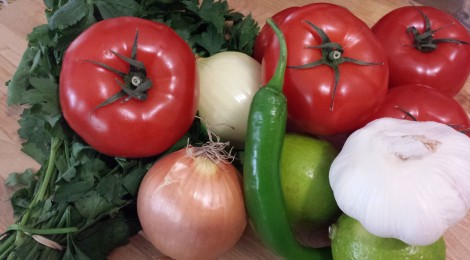
Let’z Salsa
One of the things I look forward to as the weather begins to warm up is having salsa but not just any salsa, it has to be Mexican style salsa fresca not TexMex which has corn and sometimes beans. For those who aren’t familiar with this, it’s fresh salsa, nothing cooked, heated or canned at all. Having lived for many years in Southern California and being married to a 4th generation California born guy, my family and I were very fortunate to experience and have access to some of the best Mexican style salsa ever!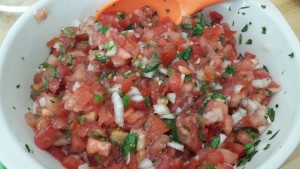 After leaving the lovely SoCal region we continued the tradition of salsa fresca but with limited access of course. In desperation, to have good quality and truly fresh, not cooked salsa, my husband and I learned to make it from scratch. In the US this wasn’t such a difficult task. As expats living in Luxembourg though this had turned this into a monumental challenge our first summer. I struggled to find the correct ingredients for the taste, spice and heat we all love so much.
After leaving the lovely SoCal region we continued the tradition of salsa fresca but with limited access of course. In desperation, to have good quality and truly fresh, not cooked salsa, my husband and I learned to make it from scratch. In the US this wasn’t such a difficult task. As expats living in Luxembourg though this had turned this into a monumental challenge our first summer. I struggled to find the correct ingredients for the taste, spice and heat we all love so much.
Not all is lost, I have achieved success with salsa! I’ve now had 2 summers of successful salsa making here in Luxembourg and I am well on my way to a fantastic third summer of enjoying this mouthwatering, naturally gluten free delight.
As I sat down to write out the recipe for this I have realized one very important thing, I don’t technically have a recipe, only a list of ingredients. This is one of those rare times when it all depends on the quality of each food, desired taste, spice level and end result depending on a particular dish or just for dipping.
This is my list of ingredients for a medium spicy salsa: tomatoes, yellow onions, fresh garlic, jalapeño peppers, fresh coriander (cilantro), limes and fresh ground sea salt. Everything is cut up and mixed in one large bowl, it’s not too complicated. When I make a batch of salsa, I usually aim for about 2 liters (my large mixing bowl) since it will keep in the fridge for about 7-10 days and my family devours it. We pretty much eat it with just about everything, even on omelets.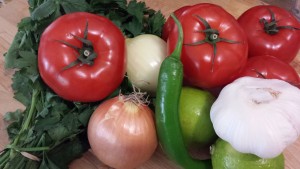
For tomatoes, I prefer a beefy tomato since too much of the seedy, liquidy stuff inside makes for a really wet salsa. Since they aren’t always readily available here I will use any tomatoes I can find and scoop out a good portion of the insides and set to the side. When everything else is assembled, if I feel the salsa is too dry then I add in more of the tomato insides to get the desired consistency. Chop the tomatoes but not too small. I usually use about 7-10 since it all depends on size and meatiness.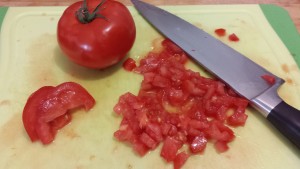
I use 2-3 onions depending on their size. Chop them well. My general rule of thumb is 3:1, tomatoes to onions. As for garlic, this will vary greatly as well. The clove sizes are all over the place. For the 2 liter batch I make it takes about 2-3 tablespoons worth and I just use the garlic press for simplicity.
The big substitution we’ve made here is with the chili pepper. Back in the US we used Serrano chilies but they are extremely difficult to find here. During a very short period of summer I can find them at the Auchan in Kirchberg. Obviously the limited availability doesn’t work too well so I have tried to use what is readily available. Most chili peppers don’t have specific types or labels in the markets but are all grouped together as chili peppers green, red and yellow. The local and quite hot chili pepper here is the Pili Pili but it’s flavor is all wrong for our Mexican flavor preference. So, we’ve landed on the jalapeño which has been terrific. Slice the chili down the length and remove seeds but if you want extra spice then leave some or all of them in. Finely chop the chili. Be sure to wash your hands well after this one so you don’t make the mistake of rubbing your eye…yup, it happened but only once.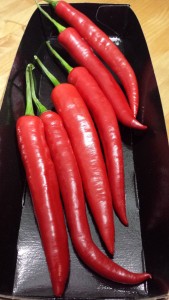
Coriander (aka: cilantro) is widely available and in varying bunch sizes. I use about ½ of a large bunch similar to that of the parsley bunches or 2 of these plastic containers from the fresh herb section. Chop finely, including the stems unless they are very woody then remove that part. At this point mix all these ingredients together well.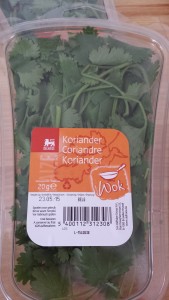 With the limes, roll them with gentle pressure around the counter to loosen up the juice inside. Again, this is one of the ingredients that is quite adjustable to your particular taste. As for me, I usually use 2-3 limes. I zest one lime and then hand squeeze it in allowing the pulp to fall in too. Squeeze the remaining limes. The little bit of zest adds a nice zing to the flavor, too much zest can make it bitter. This is something you can experiment with.
With the limes, roll them with gentle pressure around the counter to loosen up the juice inside. Again, this is one of the ingredients that is quite adjustable to your particular taste. As for me, I usually use 2-3 limes. I zest one lime and then hand squeeze it in allowing the pulp to fall in too. Squeeze the remaining limes. The little bit of zest adds a nice zing to the flavor, too much zest can make it bitter. This is something you can experiment with.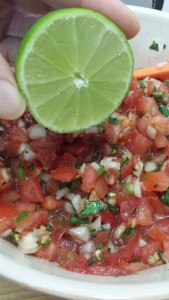
The last part of this assembly process is to grind your salt into it. The salt wakes up the tomatoes and helps to release their juices. I’ve tried to leave it out (you know, reduce sodium intake) but the flavor ends up very flat. Start with a bit, stir and taste. You will notice as you add salt the flavor will intensify and seemingly blend together and not just taste like a bowl of cut up veg. I often add about 1/2 teaspoon or so of salt and then let the whole mixture rest for about 10-15 minutes to lightly marinate. After marinating for a time I can then tell what adjustments need to be made for flavor and do so accordingly.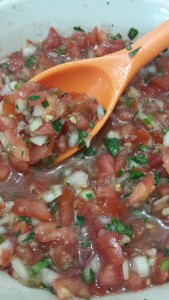
In all honesty, the salsa is delicious at this point and ready to be consumed which often happens in my house. The best salsa fresca though is one that is allowed to marinate anywhere from several hours to overnight.
All these ingredients can be increased or decreased according to your own preferences. You can experiment with flavors and consistency like chopped, partially blended or fully blended which are all great ways to serve salsa.
I have a little tip for storage, reuse these plastic containers you get when purchasing the pre-cut pineapple at the big Luxembourg supermarkets. They seal well, stand tall for space saving in the fridge and will hold the strong scent in. The smell of the salsa can stain plastic ware making it hard to use with other foods. I’ve been putting these containers in the dishwasher for years and they hold up nicely as you can see. I keep a supply of these on hand just for salsa. You can store in glass too but I would advise against storing in any type of metal as this is highly acidic and the reaction with some metal can ruin the flavor.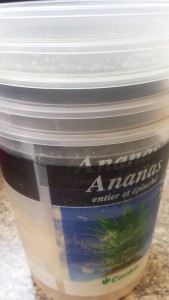





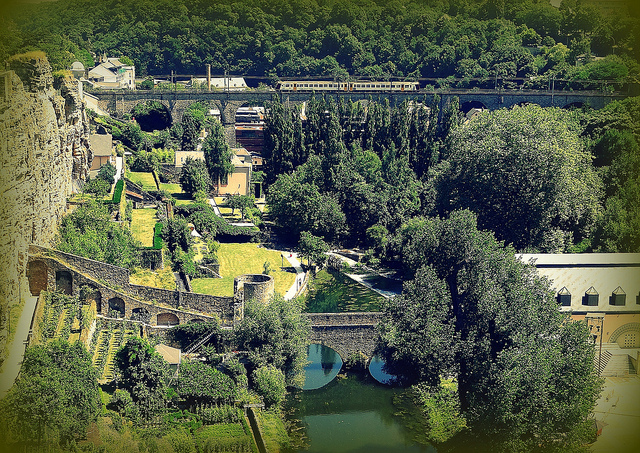


recent comments